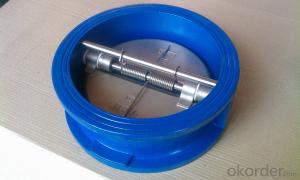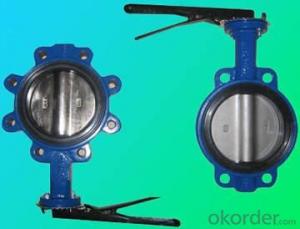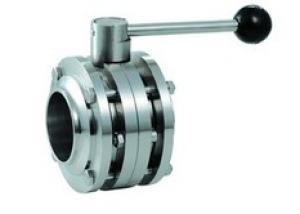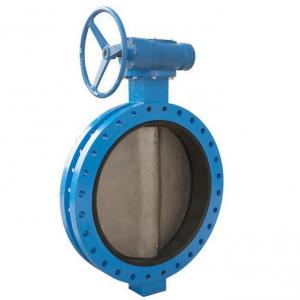Butterfly Valve Marine Stainless Steel High Quality
- Loading Port:
- China main port
- Payment Terms:
- TT OR LC
- Min Order Qty:
- 1000 pc
- Supply Capability:
- 10000 pc/month
OKorder Service Pledge
OKorder Financial Service
You Might Also Like
1. Manual Wafer Butterfly Valve Description:
A butterfly valve is a valve which can be used for isolating or regulating flow. The closing mechanism takes the form of a disk. Operation is similar to that of a ball valve, which allows for quick shut off. Butterfly valves are generally favored because they are lower in cost to other valve designs as well as being lighter in weight, meaning less support is required.
2.Main Features of the Manual Wafer Butterfly Valve
Butterfly valveis exclusive pneumatic elements controlling the actions of the brake and cluth of a press. It ensure that cluth and brake maintain a certain procedure of gear-in and release, i.e. when press starts the brake shall first release for 0.03 sec before clutch gear-in; and when the press stops, the clutch shall first release for 0.01 sec before brake active.
Quick DetailsStandard or Nonstandard: Standard Structure: Gate Pressure: Medium Pressure
Power: Manual Material: Casting Temperature of Media: Medium Temperature
Model Number: CMAX-GF4 resilient gate valves: resilient seat flange
Packaging & DeliveryPackaging Detail: air plastic bag inside/wooden box outside
Delivery Detail: 15-60days
a)Cast hole. Flange connection meet ANSI 125/150# DIN PN10/16 BS4504 PN10/16 in the meanwhile.
b)Soft seat. Replaceable. Increase of service life.
c)Double half shaft without pin.
d) Square and short neck. Easy to stick scutcheon and cost saving.
3. Manual Wafer Butterfly Valve Images:
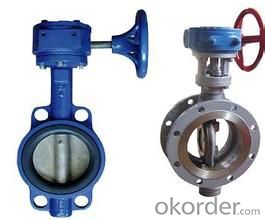

4.Manual Wafer Butterfly Valve Specification:
1) Sizes: DN40mm-DN1400mm2) Materials:
Body: CI(cast iron ,GG25 )/ DI (ductile iron ,GGG40)Seat: EPDM / NBR / TEFLON / VITON
5.FAQ
1. What is the working principle of manual wafer butterfly valve?
A: A butterfly valve is from a family of valves called quarter-turn valves. In operation, the valve is fully open or closed when the disc is rotated a quarter turn. The "butterfly" is a metal disc mounted on a rod. When the valve is closed, the disc is turned so that it completely blocks off the passageway. When the valve is fully open, the disc is rotated a quarter turn so that it allows an almost unrestricted passage of the fluid. The valve may also be opened incrementally to throttle flow.
2. What is manual wafer butterfly valve?
A: Wafer style is the more common of the two and is less expensive than the lug style. The wafer style butterfly valve is just about the standard. It ís so common that no one even bothers to use the word "wafer" when ordering a butterfly valve. It is taken for granted that if a butterfly valve is ordered, a wafer style will be received.
3. How about the Installation of the Wafer Style Butterfly Valve?
A: Butterfly valves are installed by inserting the valve between two flanges using bolts or studs and nuts to hold it all together. This type of installation, of course, makes it impossible to disconnect just one side of the piping system from the valve. That benefit is received using the lug style valve.
- Q: What's the use of fire butterfly valve?
- Fire butterfly valve is the abbreviation of fire signal butterfly valve, which belongs to a kind of fire valve.Fire valve is an important accessory on the industrial and building pipelines. The fire fighting valve is composed of three parts: valve body, headstock gear and valve cover. Among them, the fire signal butterfly valve has the advantages of simple structure, reliable sealing, light opening, long life, convenient maintenance and so on. It is widely used in water supply and drainage, building, fire fighting systems, all kinds of pipelines, especially in fire lines.
- Q: Classification of telescopic butterfly valve
- (2) temperature butterfly valve. 120 C<t<450 C butterfly valve(3) normal temperature butterfly valve. One 40C<t<; 120 C butterfly valve(4) low temperature butterfly valve. One 100<t< one, 40 C butterfly valves(E) ultra low temperature butterfly valve. T< one, 100 C butterfly valve (1) clip butterfly valve(2) flanged butterfly valve(3) lug butterfly valve;(4) welded butterfly valve
- Q: Transformer butterfly valve and pressure relief valve difference
- I don't know. Let's have a Baidu! Baidu is powerful.
- Q: What's the difference between a butterfly valve and an eccentric butterfly valve? What is the difference in field applications?
- Avoid friction and wear on the sealing surface!And, at the time of closing, and opening the opposite, there is a better sealing effect! Now generally use eccentric butterfly valve as the main. That's all I know! If there is any mistake, please forgive me!
- Q: How do you draw the butterfly valve in the engineering drawing?
- There is one of the most stupid way: find a picture of the butterfly valve, insert into the CAD, and then follow the trace, and there is a lot of CAD on the network of butterfly valve, yourself down..
- Q: 1st where is my zone valve? I have an old Burnham gas baseboard heater2nd What do I do?My last resort is calling a proffesional.
- if your sure its not the thermostat than the zone valve should be near the boiler in the copper line. Most valves have a flat lever that slides when it is powered up to open. You can open manually by sliding the lever
- Q: oil coming from valve into turbo charger
- it's located on pg 61222 of gm shop repair manual
- Q: CAD drawing of butterfly valve
- Your question is very international. Ha-haThis method of painting is not clear in one or two words.First you'll know the map, then you'll use CAD, so the two will add up.Guess you will.
- Q: What kind of butterfly valve is sd342x?
- Sd342x: two-way double eccentric soft sealing butterfly valveS: two way pressureD: butterfly valve3: turbine operation4: flange connection2: double eccentricX: rubber sealProbably the shape is not so good in appearance,Double eccentric mostly elastic sealThree eccentric is multi-layer sealHope to be of help to youOpened valve Co., Ltd. on the production of butterfly valve
- Q: can't locate freon intake valve for 03 jaguar an was wondering were it is located at
- If it has one it should be located on the smaller line near the AC compressor.
Send your message to us
Butterfly Valve Marine Stainless Steel High Quality
- Loading Port:
- China main port
- Payment Terms:
- TT OR LC
- Min Order Qty:
- 1000 pc
- Supply Capability:
- 10000 pc/month
OKorder Service Pledge
OKorder Financial Service
Similar products
Hot products
Hot Searches
Related keywords







